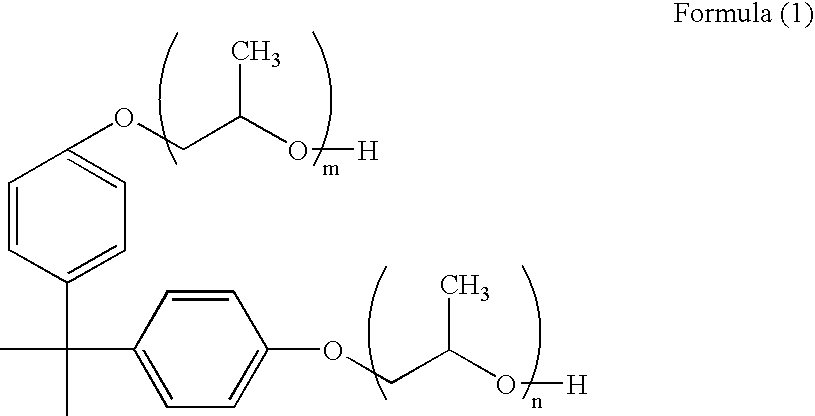Electrostatic developing toner, method of producing the same, electrostatic developer and image forming method
a technology of electrostatic development and toner, which is applied in the direction of electrographic process, electrographic process using charge pattern, instruments, etc., can solve the problems of reducing color development characteristics, difficult to achieve all of the lowering fixing temperature, and the desired toner shelflife, etc., to achieve the effect of satisfying image characteristics
- Summary
- Abstract
- Description
- Claims
- Application Information
AI Technical Summary
Benefits of technology
Problems solved by technology
Method used
Image
Examples
example 1
[0148]
[Preparation of toner particles (1)]Non-crystalline polyester 800 parts by weightresin dispersion liquid (1):(solid content: 240 parts by weight)Colorant dispersion liquid:22.87 parts by weight(solid content: 5.3 part by weight)Releasing agent dispersion liquid: 50 parts by weight(solid content: 10 parts by weight)Nonionic surfactant 0.5 part by weight(IGEPAL CA897):
[0149]The above raw materials except for 224 parts by weight (solid content: 67 part by weight) of the non-crystalline polyester resin (1) are put in a 5 L cylindrical stainless container. The components in the container are subjected to dispersing and mixing treatment for 30 minutes by ULTRATURRAX at 8000 rpm while shear force is applied. Then, 0.14 part by weight of an aqueous 10% nitric acid solution of aluminum polychloride as a coagulant is added dropwise to the mixture. During the addition of the coagulant, the pH value of the raw material dispersion liquid is adjusted within a range of 4.2 to 4.5. 0.3N nit...
example 2
[Preparation of Toner Particles (2)]
[0157]Toner particles (2) are produced in the same manner as the preparation of the toner particles (1) in Example 1 except that 672.1 parts by weight of the non-crystalline polyester resin dispersion liquid (2) is used in place of 800 parts by weight of the non-crystalline polyester resin dispersion liquid (1) and that 127.9 parts by weight of the crystalline polyester resin dispersion liquid (7) is further used. The volume average particle diameter of the final toner particles is measured by a Coulter Counter (trade name: TA-II model, manufactured by Coulter Company, aperture diameter: 50 μm), and found to be 5.8 μm. The volume average particle diameter distribution was found to be 1.24, and the content of titanium is found to be 100 ppm.
[Preparation of a Developer and Evaluation of Image Quality]
[0158]An electrostatic image developer (2) is prepared in the same manner as in Example 1 except for using the toner particles (2) instead of the toner...
example 3
[Preparation of Toner Particles (3)]
[0159]Toner particles (3) are prepared in the same manner as in the preparation of the toner particles (1) in Example 1 except that 629.5 parts by weight of the non-crystalline polyester resin dispersion liquid (3) is used in place of 800 parts by weight of the non-crystalline polyester resin dispersion liquid (1) and that 170.5 parts by weight of the crystalline polyester resin dispersion liquid (7) is further used. The volume average particle diameter of the final toner particles is measured by a Coulter Counter (trade name: TA-IL model, manufactured by Coulter Company, aperture diameter: 50 μm), and found to be 6.2 μm. The volume average particle diameter distribution is found to be 1.24, and the content of titanium is found to be 150 ppm.
[Preparation of a Developer and Evaluation of Image Quality]
[0160]An electrostatic image developer (3) is prepared in the same manner as in Example 1 except for using the toner particles (3) in place of the to...
PUM
| Property | Measurement | Unit |
|---|---|---|
| Tm | aaaaa | aaaaa |
| Tg | aaaaa | aaaaa |
| melting point | aaaaa | aaaaa |
Abstract
Description
Claims
Application Information
 Login to View More
Login to View More - R&D
- Intellectual Property
- Life Sciences
- Materials
- Tech Scout
- Unparalleled Data Quality
- Higher Quality Content
- 60% Fewer Hallucinations
Browse by: Latest US Patents, China's latest patents, Technical Efficacy Thesaurus, Application Domain, Technology Topic, Popular Technical Reports.
© 2025 PatSnap. All rights reserved.Legal|Privacy policy|Modern Slavery Act Transparency Statement|Sitemap|About US| Contact US: help@patsnap.com

